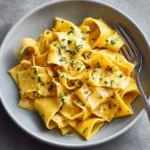
Saffron pasta is one of those dishes that feels fancy but is surprisingly simple to make at home. The moment saffron blooms into your sauce, you’ll understand why it’s known as culinary gold. In this article, we’ll explore what saffron tastes like in pasta, how to cook with it, and what it brings to your meals beyond color. You’ll also discover perfect pairings for saffron pasta and how to highlight its subtle floral notes. Whether you’re new to cooking or just new to saffron, this guide will help you turn pantry basics into something luxurious and flavorful.
Table of Contents

Saffron Pasta Recipe: Easy, Elegant, and Full of Flavor
- Total Time: 30 minutes
- Yield: 2 servings 1x
- Diet: Vegetarian
Description
Saffron pasta offers delicate floral flavor and a golden hue. Learn how to use saffron to make a luxurious, easy pasta dish at home.
Ingredients
Ingredients:
1 teaspoon saffron (see notes)
¼ cup boiling water
½ tablespoon olive oil
2 garlic cloves, finely diced
½ cup white wine
40 grams butter, cubed
⅔ cup cream
35 grams parmesan, finely grated
1 teaspoon lemon juice (or 2 teaspoons if you like)
Extra parmesan to serve
Pasta of your choice (see notes)
Instructions
Instructions:
Crush the saffron threads gently and soak them in ¼ cup boiling water for 10–15 minutes to bloom.
Heat olive oil in a pan and sauté the finely diced garlic until fragrant and soft.
Add the white wine to deglaze the pan, then pour in the bloomed saffron liquid.
Stir in the butter cubes and let them melt, creating a smooth sauce base.
Pour in the cream and simmer gently, allowing the sauce to thicken and saffron flavor to infuse.
Mix in the grated parmesan and lemon juice, stirring until smooth and well combined.
Cook your chosen pasta according to package instructions, then toss it into the sauce to coat thoroughly.
Serve immediately, garnished with extra parmesan and a lemon wedge if desired.
Notes
Notes:
For best results, use high-quality saffron threads.
You can knead bloomed saffron into fresh pasta dough for extra color and flavor.
Choose pasta shapes that hold sauce well, such as fettuccine or tagliatelle.
- Prep Time: 10 minutes
- Cook Time: 20 minutes
- Category: Main Course
- Cuisine: Italian
Nutrition
- Calories: 480 kcal
- Sugar: 3 g
- Sodium: 300 mg
- Fat: 30 g
- Saturated Fat: 18 g
- Unsaturated Fat: 8 g
- Carbohydrates: 40 g
- Fiber: 2 g
- Protein: 12 g
- Cholesterol: 95 mg
Keywords: saffron pasta, pasta recipe, easy saffron pasta, creamy saffron sauce, Pasta, white wine, cream, parmesan, butter
What does saffron taste like in pasta?
Discovering saffron’s unique flavor
Saffron pasta tastes like nothing else. The taste is subtle and gently sweet, carrying light floral tones alongside earthy undertones and a whisper of honey. A slight bitterness rounds out the flavor, giving it structure and keeping the sweetness in check. It doesn’t overwhelm your palate but lingers gently, letting each bite carry the warm, aromatic complexity saffron is known for. When used in pasta, saffron infuses both the sauce and the noodles with that signature golden hue and its distinctive scent. This makes every forkful feel a bit indulgent, almost like you’re eating a celebration. It’s a flavor you recognize instantly once you’ve tasted it.
How aroma enhances flavor
Much of saffron’s effect in saffron pasta comes from its aroma. When saffron threads are steeped in hot water—a process known as blooming—they release powerful compounds like safranal and crocin. These give the pasta its bold color and heady scent. The fragrance is earthy, warm, and slightly peppery, adding layers to the dish that you don’t even realize are scent-driven. That smell you notice while the sauce simmers? It’s not just making your kitchen smell incredible—it’s preparing your palate, setting up the depth of flavor before you take a single bite. Saffron’s aroma helps bring the entire pasta dish to life.
How to use saffron in cooking pasta
Blooming saffron the right way
The most important step when making saffron pasta is blooming the saffron properly. Never add it dry. Instead, crush the threads gently with the back of a spoon, then steep them in a few tablespoons of hot water. Let it sit for about 10 to 15 minutes. This process pulls out the golden color and releases the deep aroma locked inside each thread. Once bloomed, you’ll pour this saffron liquid directly into your sauce or pasta water. It’s a small step, but it makes a big difference in both flavor and color.
When and where to add saffron
In saffron pasta, timing matters. If you’re making a cream-based sauce, add the bloomed saffron after the garlic has softened but before you stir in cream or butter. This allows the saffron to simmer gently and blend fully without becoming muted. For oil-based or wine-based sauces, add it just after deglazing the pan. That way, the saffron has enough time to mingle with the other ingredients and infuse the whole dish. If you’re using homemade pasta dough, you can even knead the bloomed saffron directly into the flour and eggs for a golden hue and aromatic base from the very beginning.
The amount of saffron you use also matters. A little goes a long way. Typically, just 1/2 to 1 teaspoon of threads is enough for a full meal. If you overdo it, the flavor can turn metallic or medicinal. Done right, though, saffron adds elegance without overpowering the other elements in your dish.
What does saffron do to a meal?
Saffron brings depth and elegance
Saffron pasta shows how one ingredient can completely shift a dish’s personality. Saffron doesn’t just add taste—it adds atmosphere. Its warm, aromatic notes create a sense of richness that makes everyday ingredients feel refined. Whether you’re working with butter, garlic, cream, or white wine, saffron ties everything together with a golden thread. Its color is unmistakable—a vivid yellow that gives saffron pasta a beautiful, luxurious glow. That glow signals depth and care, making the dish feel more impressive than its prep time suggests.
Unlike spices that dominate the plate, saffron enhances with restraint. It softens harsh edges and smooths out flavors, adding complexity without shouting. In saffron pasta, this creates a creamy, flavorful finish that’s light on the palate but rich in character. Every bite feels elevated, even if the ingredients are simple.
Adds flavor without heaviness
One of the best parts about saffron pasta is that it tastes full and flavorful without feeling heavy. There’s no need for thick sauces or piles of ingredients. Saffron infuses the dish with fragrance and subtle flavor, giving it a well-rounded profile that feels satisfying but never overwhelming. This makes saffron pasta ideal for light lunches, elegant dinners, or even a small starter course.
Used correctly, saffron acts like a seasoning and a highlight. It pulls together everything in the pan while bringing its own unique identity. Even a modest bowl of saffron pasta feels balanced, refined, and thoughtfully prepared. When you want to serve something special with very little effort, saffron is your best-kept secret.
What pairs well with saffron pasta?

Perfect companions for saffron pasta
Saffron pasta has a gentle, luxurious flavor that pairs beautifully with a range of ingredients. Seafood is one of the top choices—think shrimp, scallops, or mussels. Their natural sweetness complements saffron’s earthy floral notes without overpowering the dish. Grilled or poached fish also works well, especially varieties like cod or sea bass. If you’re aiming for something more indulgent, saffron pasta tastes incredible alongside tender lobster or sweet crab with a touch of butter.
Vegetables can be just as effective. Roasted zucchini, asparagus, or sweet peas bring freshness and color. Their mild flavors allow the saffron to remain front and center, while adding texture and balance. Even mushrooms, especially chanterelles or oyster varieties, offer an earthy base that plays well with saffron’s depth. The goal is to choose ingredients that respect the subtlety of saffron rather than compete with it.
Wine, garnish, and finishing touches
The right wine can make saffron pasta feel like a full experience. Dry white wines such as Sauvignon Blanc, Pinot Grigio, or a light Chardonnay highlight the creamy richness without clashing with the saffron. Sparkling wine also works beautifully for special occasions, adding brightness between bites.
Garnishes matter, too. A sprinkle of fresh herbs like parsley or chives can lift the flavor and add contrast. A touch of lemon zest or a quick squeeze of fresh juice brightens the dish and highlights saffron’s delicate floral character. And, of course, don’t forget the parmesan—just enough to add umami without overwhelming the spice. Saffron pasta is all about balance: creamy but light, bold but subtle. With the right pairings, it becomes more than just a meal—it becomes the highlight of your table.
Conclusion
Saffron pasta is a wonderful way to bring elegance and warmth to a simple meal. Its delicate floral flavor and beautiful golden color turn everyday ingredients into something special. By learning how to bloom saffron properly and timing its addition carefully, you can unlock layers of aroma and taste that enhance any pasta dish. Whether you pair it with seafood, fresh vegetables, or enjoy it on its own, saffron pasta offers a unique balance of richness and lightness. Try it yourself, and you’ll see how a small pinch of saffron can make a big impact in your kitchen.
For more recipes follow me in Facebook
Frequently Asked Questions About Saffron Pasta
What does saffron taste like in pasta?
In saffron pasta, saffron adds a delicate, floral flavor with subtle earthy and honey-like notes. It’s not spicy or strong but gently aromatic, giving the dish a warm and slightly sweet profile. A touch of bitterness helps round out the taste, making the pasta feel elegant and layered.
How to use saffron in cooking pasta?
Start by blooming the saffron threads. Crush them gently, then soak them in a few tablespoons of hot water for 10–15 minutes. Pour the saffron liquid into your sauce just after the garlic has softened or once you’ve added wine or broth to the pan. You can also mix bloomed saffron into pasta dough for golden noodles.
What does saffron do to a meal?
Saffron adds complexity without heaviness. It enhances both aroma and taste, tying ingredients together with a warm, floral tone. In saffron pasta, it brings color, richness, and depth without overpowering the dish. Just a small amount can completely elevate the flavor and presentation.
What pairs well with saffron pasta?
Seafood like shrimp, scallops, or white fish works wonderfully with saffron pasta. So do vegetables like peas, asparagus, and mushrooms. Pair with a crisp white wine, add a squeeze of lemon, and finish with parmesan or herbs for a balanced, flavorful dish.
Recipes of The Same Type
Crockpot Taco Potato Casserole
